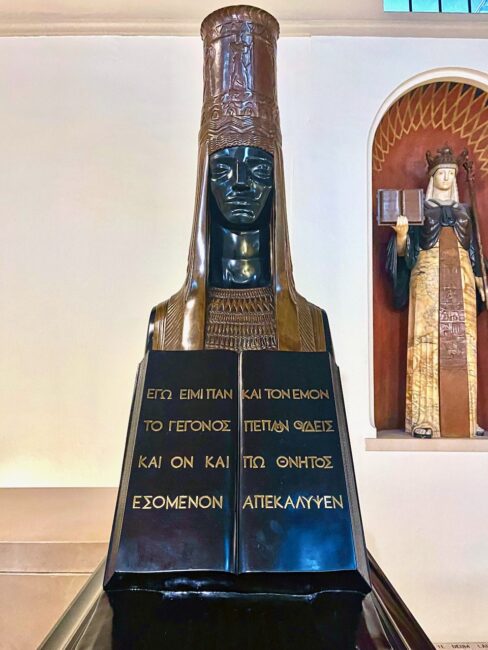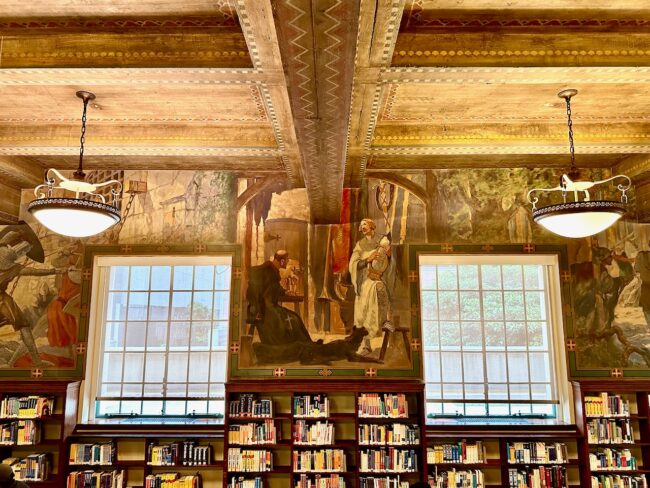
The Nethercutt Collection – Sylmar
May 9, 2023
Mercado González – Costa Mesa, CA
December 7, 2023Light Of Learning!
Los Angeles Central Library – Los Angeles
Visited: June & September 2023
Seven years ago I was quite blown away by a visit to the library, the Richard J. Riordan Central Library to be exact. Its interior was gorgeous, the exterior was created by one of the most renowned architects of his generation and the tour of this facility is … free! Recently, I told Tracy we should stop by to take one of those free docent tours. We parked nearby and booked it over to the library for an 11 a.m. tour (tour times vary … check their website).
Our docent recited a brief history of the building to the nine of us assembled for the Sunday morning tour. Heading outside to view the building’s exterior, She mentioned a name that rang a bell with Tracy and me, since this gentleman had been involved with another Southern California treasure we had visited previously. New York architect Bertram Goodhue, who designed the California Tower at Balboa Park (below) in San Diego (as well as numerous other buildings nationwide), was well-known for his neo-Gothic and Spanish colonial designs.
The Library Board had hoped Goodhue would incorporate the Spanish Colonial Revival style he used for San Diego’s Panama California Exposition in his design, however he went for a more simple and modern design for this project; still considered to be one of the “most innovative of his career.” Of course, being a library, it had to be multi-storied.
The building’s facade is an early example of Art Deco. The two figures sculpted in limestone are by Lee Lawrie, who also provided the interior sculptures. Lawrie and Goodhue collaborated on a number of projects. The two figures are called Phosphor and Hesper, personifying the morning and evening stars.
Tracy and I recalled Lawrie for his Reredos at the Saint Thomas Church on 5th Avenue in NYC, which we viewed on a trip in 2014.
In between Phosphor and Hesper is a relief of a horseman passing a torch.
 Since the Central Library was Goodhue’s crowning achievement, it makes sense that the central tower is topped with a tiled mosaic pyramid. But why a pyramid and not a dome? The docent explained that at the time of the building’s construction, the U.S. was in the midst of an Egypt-mania craze due to the recent discovery of King Tut’s Tomb.
Since the Central Library was Goodhue’s crowning achievement, it makes sense that the central tower is topped with a tiled mosaic pyramid. But why a pyramid and not a dome? The docent explained that at the time of the building’s construction, the U.S. was in the midst of an Egypt-mania craze due to the recent discovery of King Tut’s Tomb.
This Pyramid scheme includes suns on either side with a hand holding a torch representing the “Light of Learning” at the apex. Actually, most all of Lawrie’s sculptures for the library revolve around that same theme …“Light of Learning.” Pretty cool stuff. On the building is inscribed a quote,“et quasi cursores vitai lampada tradunt,” which loosely translated means (or so I’m told), “And like runners, they pass on the torch of life.”
It’s too bad Goodhue never got to see the completed structure. The Central Library (located in what is called the Goodhue Building) would sadly be Goodhue’s architectural swan song as he died unexpectedly a few days before his 55th birthday in 1924. His associate, Carleton Winslow, took over supervision of construction finishing the building in 1926.
The Maguire Gardens are named for Robert Maguire, who was the real estate developer that played a huge part in preserving the Goodhue Building and helping to restore the building and its grounds after the devastating arson fire of 1986. We’ll get to that shortly. The gardens contain a few fountains of note. The Central fountain is named “Spine,” not for the body, but for the spine of a book. There was water in them when I took the one on the right in 2016.
In one nook is the “Grotto Fountain,” which “pays tribute to civil liberties and each individual’s inalienable right to knowledge … It draws upon the 14th Amendment to the Constitution, and the words of Frederick Douglass.” Unfortunately, there is no water in this fountain either at the moment, so this photo from 2016 must suffice.
Many people use these tranquil gardens as a place to meditate, read or just hang out on a warm day. Unfortunately, it is now also a place where some of L.A.’s homeless find refuge, so be aware of your surroundings as you admire the building.
The last thing of interest I encountered in the garden on my first visit in 2016 was The World Peace Bell, an internationally recognized symbol of world peace. The World Peace Bell Association is located in Tokyo, and it presented the bell to the City of Los Angeles in 2001. Unfortunately, it is now surrounded by yellow tape for its protection.(photo from 2016)
We are very lucky the Central Library is still standing. On April 29, 1986, an arsonist set the library ablaze (the culprit is still unknown, although our docent said they have a very good idea of who did the deed). The subsequent fire destroyed nearly 400,000 books, while nearly three quarters of a million more had water damage.
In order to raise funds for the repairs and renovations, the library sold its “air rights” to Maguire Thomas Partners, the developer of the nearby U.S. Bank Tower (originally called the Library Tower). Docent Lisa explained that in Los Angeles buildings own air space up to 40 stories above their properties. As the Goodhue building was only four stories, the library had an extra 36 stories of air space available, which was sold to developers who wanted to build a building taller than allowed at that time (I never knew that you could do that). The 73-story Library Tower was completed in 1989 and is now the second-tallest building in Los Angeles and 22nd tallest in the United States (per the usually never wrong Wikipedia). Maguire also purchased all the ground surrounding the library from the City and restored the courtyard and park and built the nearby underground garage ($1 parking on weekends with a library card!) for library patrons and as additional parking for the U.S. Bank Tower. (If you are interested in learning more, check out the library blog) Photo below is courtesy of The Library Tower File.
It took more than seven years to complete the renovation, but on October 3, 1993, the library reopened. Today, the Central Library, which is the third largest research library in the United States, houses in its Rare Books Department more than 16,000 volumes that date back to the 16th century. Most of these books are from the 18th and 19th centuries.
Our tour (as well as the one seven years ago) started in the Main Lobby, one of the “new” rooms with a rather unorthodox ceiling. Artist Rene Petropoulos painted this colorful ceiling incorporating the names of numerous Los Angeles authors. The Community Redevelopment Agency has called The Seven Centers (the ceiling’s formal name) “an abstract montage celebrating Los Angeles’s literary life and contributions.”
Walking up a flight of stairs, we were greeted by Lawrie’s Triumph of Civilization sculpture …
… flanked by two sphinxes. The sphinxes symbolize “the hidden mysteries of knowledge,” something I have yet to discern.
If you look closely, Civilization (as she is referred) is wearing a helmet with a model of the library, crowned with angels that also refer to the city’s name along with the California Bear and star.
There is also a copper panel superimposed on the sculpture representing the history of civilization. The images go from the bottom to the top. They are “the Pyramids for Egypt, a ship of the Phoenicians, the Winged Bull of Babylonia and a tablet bearing the Ten Commandants, the Lion Gate of Mycenae and the Parthenon for the archaic and classical Greeks, Romulus and Remus for Rome, a dragon for China, the god Siva for India, Notre Dame for Medieval Europe, the Plumed Serpent Head for the pre-Columbian Mayans, and a buffalo, covered wagon and the Liberty Bell for the United States.” You need good eyes, the internet or a knowledgeable guide to figure that all out.
The following area in the library garners a “Wow” from most who enter. Designed by Goodhue, the Lodrick M. Cook Rotunda is the focal point of the library. The dome in this room is 64 feet tall…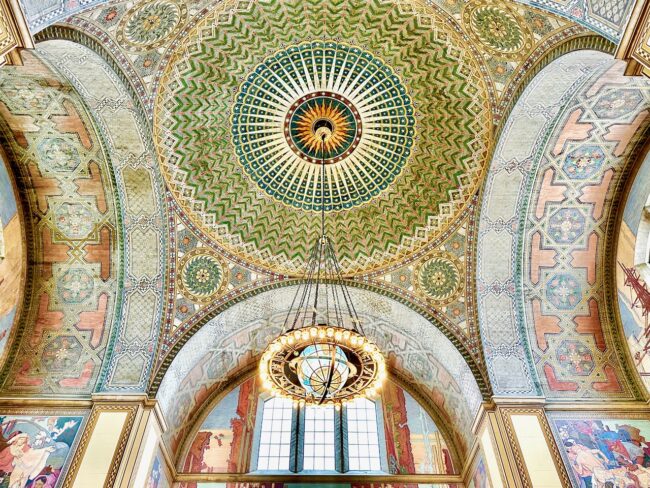
… highlighted by an incredible chandelier (designed by Goodhue Associates and modeled by Lawrie), cast of bronze and weighing in at a mere one ton. Tracy took a chance there wouldn’t be an earthquake and stood underneath to take some photos.
The chandelier represents the solar system with a globe that is surrounded by the planets and a crescent moon in chains. The 48 lights represent the 48 states that were around back when the building opened in 1926 (sorry Hawaii and Alaska).
The rotunda is full of murals painted by magazine illustrator Dean Cornwell depicting four eras of California history.
Building of the Missions.
Americanization of California.
And the Founding Of The Pueblo of Los Angeles.
It took five years for Cornwell to paint these murals which were installed in 1933. Not to be outdone, the incredible ceiling was painted by Julian Garnsey, a noted Southern California artist.
The Children’s Literature Room is also a place of beauty and serenity……containing murals depicting California history from artist Albert Herter.
The carpets have some whimsical aspects, the “swiggles” are the exact outline of figures from Cornwell’s rotunda mural.
The ceiling in this room was pretty colorful, too.
We couldn’t bear to leave this area, but it was time to move on.
It was hard to find anywhere in the library without an interesting ceiling.
In the nearby alcove is the “Torch of Illumination,” which represents “the learning process and the knowledge that is passed from one generation to the other.” This Torch used to adorn the top of the building, but it was replaced with a replica. You might even even say it was “gripping.”
We entered the more high-tech section of the library. The Tom Bradley Wing (named for L.A.’s former mayor) was designed by architect Norman Pfeiffer, and opened in 1993. This area doubled the size of the Central Library to 540,000 square feet. There are three large, whimsical chandeliers over the Atrium which are the creation of Therman Statom.
Made of fiberglass, they weigh about one ton apiece, and represent three themes; the Natural World, the Man-Made World and the Spiritual World.
The four escalators in the Atrium are illuminated by Anne Preston’s lanterns (called Illumination). The 13 1/2 foot tall columnar light fixtures refer to “light, understanding and books.”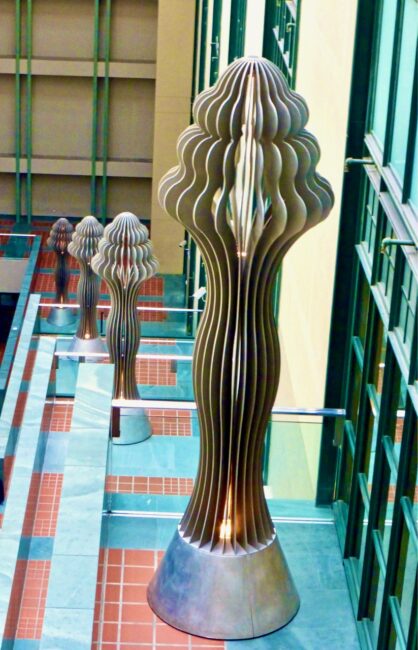
In my first visit, I took an interesting elevator ride down to the bottom of the Atrium; interesting because the inside of the elevator is decorated with old Catalogue Cards.
Since the pandemic, the tour uses the escalators to go down instead, however our docent did show us a room where you can get your Dewey Decimal System fix if needed.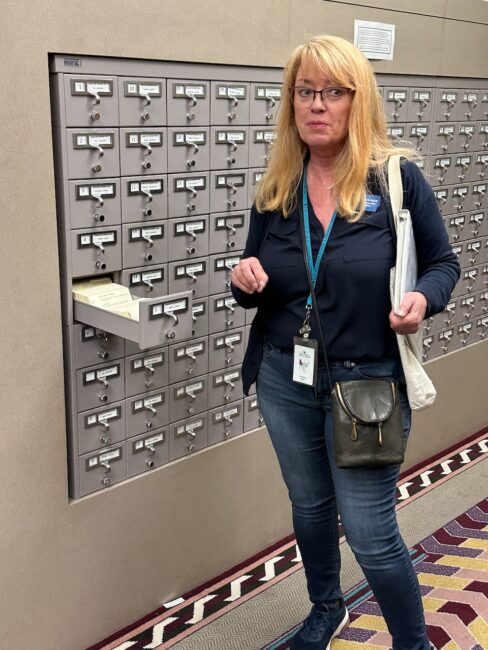
The view of the chandeliers from the bottom was very cool as we rode the escalators back up…
…giving us interesting viewpoints of these one-ton, unique lighting fixtures.
Back on top, we walked over to the entrance of the Mark Taper Auditorium, which hosts various events in its 235-seat venue with the words “The World Is My Book” looming over its entrance.
At the top, we ventured into the International Languages Department. There’s a bronze bust of Lebanese poet and author Gibran Khalil Gibran, which was donated by the World Lebanese Cultural Union to the library in 2014.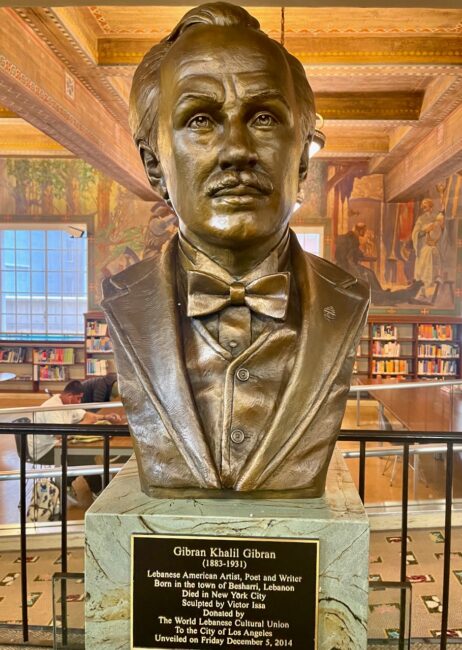
Here we saw a set of murals, which were the only portion of the east wing that escaped demolition during the seven year renovation project. Julian Garnsey (who also painted the ceiling in the Rotunda) and A.W. Parsons painted the murals depicting scenes from Walter Scott’s historical novel Ivanhoe.
They cover the entire upper wall surface of this relatively small room.
The ceiling is painted to simulate wooden beams suggestive of old Normandy and “completes a castle-like environment meant to spark children’s imaginations.” 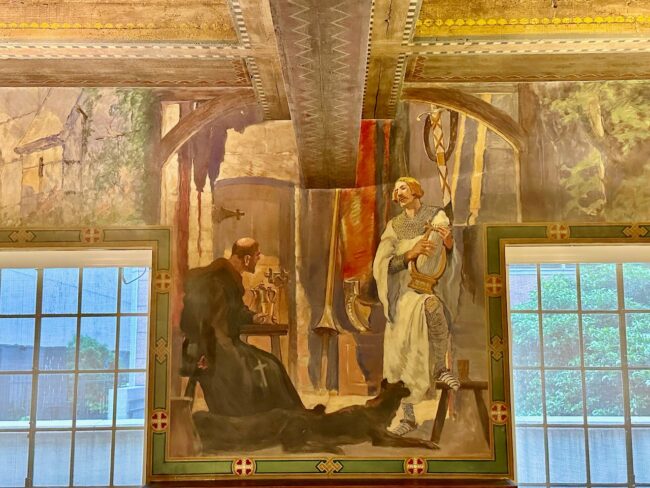
Our hour-long tour was complete, admiring the library’s beauty and absorbing its history as we listened to our knowledgeable docent. 
The Central Library speaks volumes about the myriad of attractions to see in the Los Angeles area, so whether tourist or nearby resident, take a page out of our book and check out a free tour of this famed library (and maybe even a book).
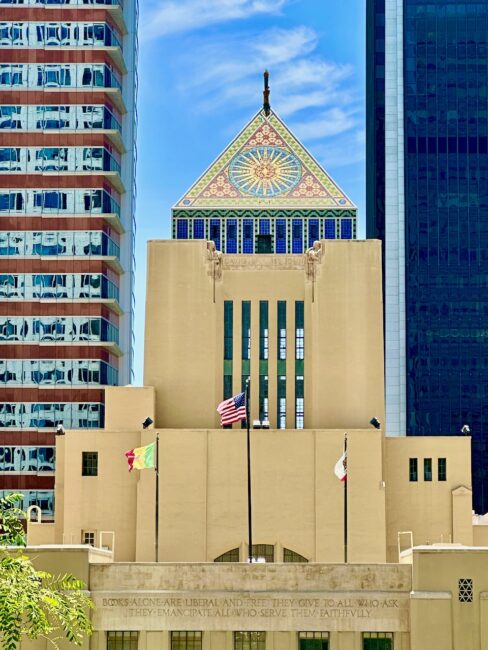 I think you’ll find it a novel experience.
I think you’ll find it a novel experience.
Los Angeles Central Library
630 W 5th St.
Los Angeles, CA 90071
213.228.7000
Monday – Thursday 10 a.m. – 8 p.m.
Friday/Saturday 9:30 a.m. – 5:30 p.m.
Sunday 1 p.m. – 5 p.m.
Tour times vary (check website …free)
Parking: 524 South Flower Street Garage
Metro: Pershing Square (4 minute walk)
Docent Tours Central Library








